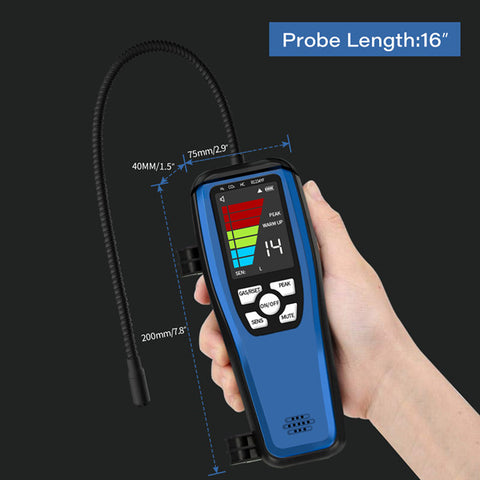Heated Diode Leak Detector
The heated diode leak detector is one important part of the refrigerant leak detector family. It is a little expensive and more advanced that the old class detectors (Corona senor).
Now it is widely applied in the HVAC industry and start to take over more shares than the old version.
 |
 |
What is the Heated Diode Leak Detector?
Heated Diode refrigerant leak detectors trigger an absolute concentration of refrigerant. Simply put, as you move closer to the leak, the audible and visual indication increases in frequency because more refrigerant is passing the sensor.
Why do We Need the Heated Diode Leak Detector?
The heated sensor refrigerant leak detector is quickly becoming the most common type of detector seen in the field today. Sure, there are other models such as Corona Suppression and Infrared but the good majority of tools out there are heated diodes.
 |
 |
 |
 |
Pros. & Cons of Heated Diode Leak Detector
Of course, nothing is perfect, so does heated diode refrigerant leak detector, it also has some pros and cons.
Pros
The heating diode sensor is also very sensitive to minimize leakage. Some top-of-the-line models can detect a leak of 0.006 ounces per year. Try to achieve this recognition level with the corona suppression model!
This type of detector allows you to move the probe precisely to the leak point and then hover the mouse over it to detect very small leaks. Infrared detectors should always be swept back and forth, not kept in one place.
 |
 |
 |
 |
Cons
The biggest disadvantage of these types of detectors is the price, it’s a little higher than others. However, count the about 500 hours of sensor life, another alternative sensor, as well as portable carrying bags, it’s worth it.
Tips: The heated sensor takes some time to warm up before it is used. Depending on the model, this may take 30 seconds or two minutes, or more.
Preferred Heated Diode Detectors
As per normal practice, let’s move to the catalog page for the details of Aprvtio LD-200 Heated Diode Leak Detector for HVAC, Car, and Refrigerator.
 |
 |
Features of Heated Diode Leak Detector
1. Advanced Heated Diode Sensor: The Freon leak detector is equipped with High-precision heated diode sensor with less interference from other gases (compared to the corona sensor). It can quickly identify all halogenated refrigerants including CFCs, HFCs, HCFCs, HCs, HFOs, and mixed refrigerants such as R11/R22/R404a/R410a/R600a/R1234yf
2. Easy to Operate: With a five-key design and it allows to fast reset, mute, power on/off, adjust sensitivity, mark the peak value of leakage, and makes the LED screen visually display the leakage level and device status in one simple click.
3. Three Sensitivity Adjustments: The refrigerant gas leak detector can detect all kinds of halogen gas leakage in three sensitivities(L-M-H) adjustments and respond to the results in real-time.
4. High Efficiency: The detector warms up in the 30s and responds in 3s; Maximum sensitivity up to 0.14oz/yr. The built-in 3000mAh rechargeable battery provides continuous 6 hours of working time.
5. Worries Free Gas Detector: We offer 7*24 services and a one-year warranty for the heated diode gas leak detector.
 |
 |
How do Heated Diode Refrigerant Leak Detectors Work?
Before introducing the principles of the work, we should know the basic types of Refrigerants first.
This type of detector heats the refrigerant to break down the molecules. When the molecule is destroyed, positively charged chlorine or fluorine ions appear. Heated diodes detect these ions and emit sound, visual, or two alerts.
This means that a heated diode leak detector can smell almost any refrigerant used today. Why is that? Most refrigerants contain chlorine or fluorine. Let's take a look at some of the most popular refrigerants and types on the market today.
 |
 |
CFCs - Chlorofluorocarbons are now phased out worldwide because of the chlorine they contain. Chlorine was found to destroy ozone when released or discharged. Common refrigerants in this category are R-12 and R-502.
HCFCs - Chlorofluorocarbons are almost identical. It also leaked recently because it contained chlorine. The most popular refrigerant in this category is the R-22. (R-22 has been the standard refrigerant for home refrigeration for more than two decades.)
HFCs - Hydrofluorocarbons are slightly different. Chlorine has been removed from these new refrigerants to save the ozone. The only constant chemical left is fluorine. (Remember, this is another chemical that heating diodes recognize.) HFC is the most popular and most used refrigerant in the world, such as R-134A, R-404A, and R-410A. The name is included. You may be using HFC refrigerants while working on the device.
 |
 |
HFOs - Hydrofluorolefin is a new refrigerant designed to replace HFC refrigerants. Like its sister, HFC contains fluorine. These refrigerants are currently developed in laboratories by Honeywell and Chemours and can already be found in practical applications, such as B. working on new cars or using FO-1234YF instead of R-134A. There are also.
Perhaps you have noticed that each refrigerant class contains one of the most important chemicals, namely chlorine or fluorine. Most refrigerants contain both chemicals, but not everyone does.
It is worth noting that your heating diode detector cannot find a class of refrigerants, namely hydrocarbons. Hydrocarbons are natural refrigerants, such as ammonia, propane, and isobutane. If you are a housing engineer, you may never meet them. However, if you are a refrigeration or freezer technician, you may have encountered this in a supermarket or freezer. In these cases, a hydrocarbon detector is required.
Why Choose Aprvtio?
Aprvtio has over 20 years of experience in the HVAC industry, we manufacture test and measure instruments for HVAC and refrigeration professionals. We are the industry expert and provide efficient tools to help engineers find and resolve issues quickly. Our aim: provide expert tools for efficient solutions. Save your time and cost.
Just come and have a look at our choice!

